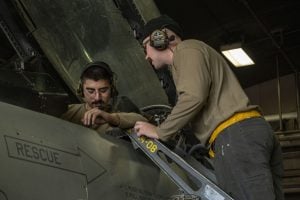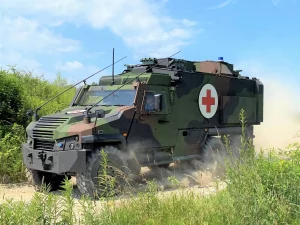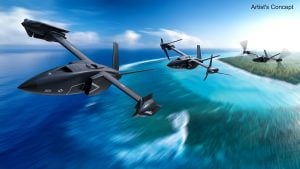Make in India RFP for MEAT
- Request for Proposal RFP to procure indigenously designed target system ‘Manoeuvrable Expendable Aerial Target’ for Indian Army issued.
- MEAT is a system based on jet engine consisting of an airborne vehicle and ground control / support systems suitable for exercising and evaluating surface to air, guns, and missiles.
- For its Air Defence (AD), the Indian Army has given its sanction for prototype development of ‘MEAT’ (Manoeuvrable Expendable Aerial Target) under the `Make II’ Category.
- To ensure that there is no delay for want of funds, the project which has been in the pipeline for a couple of years is under Make II category so that it is fast tracked.
- For its Air Defence (AD), the Indian Army has given its sanction for prototype development of ‘MEAT’ (Manoeuvrable Expendable Aerial Target) under the `Make II’ Category. According to a senior army officer, “For giving realistic training to the men during annual exercises there is a need of suitable aerial target system. Such training is important as the Indian Army has different AD platforms for missiles and gun systems and the crew has to be trained to operate these.”
- To ensure that there is no delay for want of funds, the project which has been in the pipeline for a couple of years is under Make II category so that it is fast tracked.
- Since the Indian Army needs 50 per year, companies including: Mumbai based Sure Safety Solutions Pvt Ltd; Bangalore based Micronel Global Engineering Pvt Ltd.; ADCEPT Technologies Pvt Ltd.; Kinetix Solutions Pvt Ltd.; and L&T in Mumbai have been identified to develop prototypes. The decision was taken earlier this month.
- Under the Make II category in the Defence Procurement Procedure (DPP), there is no funding required from the Ministry of Defence (MoD), whereas under the `Make’ category the MoD has to provide 90% of funds up to prototype stage.
- As per the Chapter III of DPP-2016, the ‘Make’ procedure for indigenous design, development and manufacture of defence equipment/ weapon systems was simplified in 2016. And a new sub-category — Make-II (industry funded) — was introduced.
- As has been reported by Financial Express Online earlier, according to the procedure the major focus is on the development of equipment/ system/platform or their upgrades or their subsystems/sub-assembly/assemblies/components.
- Also, no government funding is mentioned for the development of the prototype; however, there is an assurance of orders after successful development and trials.
- In 2016, the then Army Chief Gen Dalbir Singh had launched a website on the Army’s `Make’ Projects in an effort to attract the private sector companies to be involved in making the service self-reliant.
- At the time, the former chief had announced that the Indian Army will have its own Design Bureau to work along with Defence Research and Development Organisation (DRDO), Academia, DPSU’s, Ordnance Factory Board’s (OFB) and private industry. Ten projects were identified by the Indian Army for ‘Make’ category to be manufactured locally by the private sector.
- As has been reported by Financial Express Online in 2016, the Indian Army had identified the products including 125 mm smooth bore barrel with gun article, improved ammunition for T-72 and T-90 tanks, 1000 HP engines for T-72, individual underwater breathing apparatus, environment control unit and auxiliary power units for T-90 tanks, advanced pilotless target aircraft, manoeuvrable expendable aerial targets, tracked light dozers, assault track way and modern aircraft refuelling pump
4th round of India-China military talks today
- India and China will discuss troop disengagement in the Depsang-Daulat Beg Oldie sector, with New Delhi also pressing for a further pullback of Chinese soldiers in the Pangong Tso and Hot Springs areas, during the fourth round of talks between the rival corps commanders in eastern Ladakh on Tuesday.
- The delegations led by 14 Corps commander Lt General Harinder Singh and South Xinjiang Military District chief Major General Liu Lin are slated to begin their dialogue on the Indian side of the Chushul-Moldo border personnel meeting point at 11.30 am on Tuesday.
- The fourth round of the talks will also take up the eventual de-induction of the around 30,000 troops each amassed by the two sides, along with artillery guns, tanks and other heavy weaponry, in the “depth areas” along the 1,597-km long frontier in eastern Ladakh.
- The two corps commanders will of course review the progress of Phase-I of the de-escalation plan thrashed out in the last meeting on June 30, which has witnessed bulk of the rival troops pull back 1-2.5 km from the face-off points at Galwan Valley, Gogra-Hot Springs and Pangong Tso.
- There have been mounting concerns about the People’s Liberation Army (PLA) gaining the upper hand in creation of the no-patrolling zones after intruding into Indian territory, as part of its overall design to keep on pushing the Line of Actual Control (LAC) westwards.
- But Indian defence officials insist the immediate priority behind the “temporary arrangement” to create the no-patrolling zones was to avoid further clashes between the rival troops. “It does not entail any loss of territory or patrolling rights. The timelines and modalities for the next phase of de-escalation will be discussed in the meeting,” said an official.
- PLA troops have pulled back from the `base’ of `Finger-4’ (mountainous spur) eastwards towards ‘Finger-5’ on the north bank of Pangong Tso but are yet to fully vacate the ridgeline that dominates the area.
- “This will figure in the discussions because we want the PLA to gradually pull back about 8-km back to Finger-8 (where the LAC runs north to south as per India),” said the official.
- Indian soldiers have concomitantly also pulled back westwards towards their Dhan Singh Thapa post between Finger-2 and Finger-3 in consonance with the plan to disengage at the face-off site at Finger-4.
- Officials acknowledge that while Galwan Valley and Gogra-Hot Springs were largely uncontested in the past, the disengagement at Pangong Tso and Depsang will be harder to resolve.
- In the Depsang Plains area, a strategically located table-top plateau to the north of Galwan, the PLA has been blocking Indian patrols going towards Patrolling Points (PPs)-10, 11, 12 and 13 after intruding deep into what India considers its territory. India, incidentally, has 65 PPs along the LAC in eastern Ladakh.
- “The perception of LAC at Depsang vastly differs between the two sides. India will reiterate that the usual norm should be restored there about not blocking each other’s patrols,” said the official.
Mig-29K to be retired in 2034, TEDBF to join Navy in 2032
- The Navy is expected to start receiving new twin-engine aircraft carrier-based fighter aircraft being developed by the Defence Research and Development Organisation (DRDO) by 2032 and it will be a replacement for the Russian MiG-29K carrier jets in service, a defence source said.
- “The Navy is expected to get the Hindustan Aeronautics Ltd. (HAL)-built twin-engine carrier aircraft by 2032. It will replace the MiG-29Ks in service which are scheduled to start going out by 2034,” the source said. The Navy currently operates Russian-origin carrier INS Vikramaditya and expects to have the first Indigenous Aircraft Carrier (IAC-I) Vikrant operational by 2022. With a second carrier to come in, the Navy is already evaluating a global tender for 57 carrier-based twin-engine fighter aircraft.
- With the new jet under development and also factoring in budgetary constraints, the Navy is looking to revise the tender for 57 carrier-based jets downwards. The revised numbers have not been finalised yet; the source stated.
- Last January, the naval Light Combat Aircraft (LCA) successfully completed arrested landing and take-off on board Vikramaditya and has since undertaken several trials.
- Based on the experience of the carrier landing, the DRDO has offered to develop a twin-engine deck-based fighter for the Navy. With the successful deck-landing, they decided to drop the naval LCA Mk2 and move on to the twin-engine jet, the source said.
- The new jet being developed by DRDO should be ready by 2026, Navy Chief Admiral Karambir Singh stated last December. The design specifications have since been finalised.
- The Navy currently has 45 Russian MiG-29K aircraft and its officials had stated that there will not be enough aircraft to operate from both carriers.
- The Navy is currently evaluating the responses to the Request for Information (RFI) from Boeing with its F-18 Super Hornet and Dassault Aviation with its Rafale jets. Both companies had stated that their jets can operate off the ski-jump of Vikramaditya and in future the Vikrant.
- In fact, an Indian Navy team was to visit the US Naval Air Station in Maryland to witness a demonstration by Boeing on the compatibility of its F-18 Super Hornet of taking off and landing from the decks of Indian aircraft carriers. However, the visit got delayed due to the COVID-19 outbreak.
Course Completion Ceremony at INS Chilka
- Course Completion Ceremony of Passing Out Trainees of Batch 01/2020 at INS Chilka on 10 Jul 2020.
- 2471 Trainees of Indian Navy & Indian Coast Guard completed ab-initio training.
China’s J-20B Stealth Jet, Upgraded with Thrust Vector Controls, Reportedly Enters Mass Production
- The Hong Kong-based South China Morning Post reported on Monday that a new model of China’s Chengdu J-20 stealth fighter, the J-20B, is entering “mass production” with sophisticated new thrust-vector controls that significantly enhance manoeuvrability so as to “meet the original criteria.”
- According to an anonymous source cited by defense journalist Minnie Chan, commencement of production was celebrated in a ceremony on July 8 attended by the vice-chairman of China’s Central Military Commission.
- The twin-engine J-20A “Mighty Dragon” entered service in 2017, and today remains the only operational stealth jet designed outside the United States. Around 50 are believed to have been built so far.
- However, the Post reports the J-20B will continue to rely on Saturn AL-31F M2 turbofans imported from Russia rather than higher-thrust domestic WS-15 engines China is still struggling to refine for production.
- Chengdu Aviation Corporation has reportedly set up four production lines each capable of producing one J-20B per month, and the Chinese military is supposedly sufficiently satisfied with the model’s refinements to place a large order. However, Chan’s article details only one major new technology.
- Thrust Vector Control (TVC) allows a pilot to tilt the exhaust nozzles of a jet engine to redirect thrust, allowing aircraft like the F-22 Raptor and Russia Su-35S Flanker to perform jaw-dropping manoeuvres at very high angles of attack, meaning the aircraft’s nose is pointed at an angle greatly exceeding the plane’s current vector.
- Such manoeuvres may grant a pilot an edge when evading a missile or seeking an advantageous position in within-visual-range air-to-air combat.
- However, many cutting-edge jet fighters do not use thrust-vector engines. For one, manoeuvres leveraging thrust-vectoring drain an aircraft’s energy very rapidly, leaving it in a low-energy state vulnerable to follow-on attacks. This was allegedly a downside exploited by U.S. F-15 jets in a Red Flag exercise against thrust-vectoring Indian Air Force Su-30MKI jets in 2008.
- Furthermore, U.S. air combat doctrine emphasizes maintaining a high-energy state, and executing stealthy, beyond-visual range missile attacks.
- Therefore, Western designers have mostly deemed the added weight and complexity of thrust-vector controls to not be worth the added cost outside of the pricey air-to-air specialized F-22 Raptor, or jump jets like the Harrier or F-35B Lightning, which primarily exploit thrust-vectoring for short or vertical take-off-and-landing capability. However, thrust vectoring controls are common in modern Russian jet fighters.
Iran drops India from Chabahar rail project, cites funding delay
- Four years after India and Iran signed an agreement to construct a rail line from Chabahar port to Zahedan, along the border with Afghanistan, the Iranian government has decided to proceed with the construction on its own, citing delays from the Indian side in funding and starting the project.
- Last week, Iranian Transport and Urban Development Minister Mohammad Eslami inaugurated the track-laying process for the 628 km Chabahar-Zahedan line, which will be extended to Zaranj across the border in Afghanistan. Officials told The Hindu that the entire project would be completed by March 2022, and that Iranian Railways will proceed without India’s assistance, using approximately $400 million from the Iranian National Development Fund.
- The development comes as China finalises a massive 25-year, $400 billion strategic partnership deal with Iran, which could cloud India’s plans.
- The railway project, which was being discussed between the Iranian Railways and the state-owned Indian Railways Construction Ltd (IRCON), was meant to be part of India’s commitment to the trilateral agreement between India, Iran, and Afghanistan to build an alternate trade route to Afghanistan and Central Asia.
- In May 2016, during Prime Minister Narendra Modi’s visit to Tehran to sign the Chabahar agreement with Iranian President Rouhani and Afghanistan President Ghani, IRCON had signed an MoU with the Iranian Rail Ministry.
- The MoU was to construct the Chabahar-Zahedan railway as “part of transit and transportation corridor in trilateral agreement between India, Iran and Afghanistan”. IRCON had promised to provide all services, superstructure work and financing for the project (around $1.6 billion).
- However, despite several site visits by IRCON engineers, and preparations by Iranian railways, India never began the work, ostensibly due to worries that these could attract U.S. sanctions. The U.S. had provided a sanctions waiver for the Chabahar port and the rail line to Zahedan, but it has been difficult to find equipment suppliers and partners due to worries they could be targeted by the U.S., said officials. India has already “zeroed out” its oil imports from Iran due to U.S. sanctions.
- The Ministry of External Affairs and IRCON declined to comment on the issue. However, when asked if the MoU with IRCON had been cancelled, now that the project has been started without it, an official said India could still join at a “later date.”
- Meanwhile, complicating matters further, Iran and China are close to finalising a 25-year Strategic Partnership which will include Chinese involvement in Chabahar’s duty free zone, an oil refinery nearby, and possibly a larger role in Chabahar port as well.
- According to leaked versions of the 18-page “Comprehensive Plan for Cooperation between Iran and China”, being finalised by officials in Tehran and Beijing, the cooperation will extend from investments in infrastructure, manufacturing and upgrading energy and transport facilities, to refurbishing ports, refineries and other installations, and will commit Iranian oil and gas supplies to China during that period.
- Iranian officials denied a report that also suggested Chabahar port, where India took, will be leased to China. However, Iran proposed a tie-up between the Chinese-run Pakistani port at Gwadar and Chabahar last year and has offered interests to China in the Bandar-e-Jask port 350km away from Chabahar, as well as in the Chabahar duty free zone.
- Each of those possibilities should be watched closely by New Delhi, said former Ambassador to Iran, K.C. Singh. “[The Iran-China deal] impinges on India’s “strategic ties” with Iran and the use of Chabahar port. Jask lies to west of Chabahar & right before Straits of Hormuz. China would thus extend its control along the Pakistan-Iran coast,” he cautioned.
REVIEW QUESTIONS
- MEAT full form:
- Manoeuvrable Expansive Aerial Target
- Marked Expansive Aerial Target
- Manoeuvrable Expendable Aerial Target
- Marked Expendable Aerial Target
ANSWER: C
- TEDBF full form:
- Twin Engine Dominance Based Fighter
- Twin Engine Deck Based Fighter
- Twin Engine Deck Based Falcon
- Twin Engine Dominance Based Falcon
ANSWER: B





















